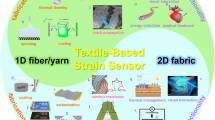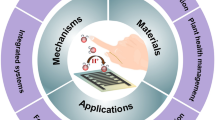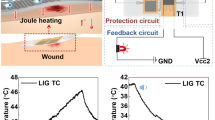Abstract
Research in rehabilitation engineering has shown that electrodes can produce tactile sensations with appropriate electrical signals to stimulate the multiple tactile receptors located under the fingertip skin. Numerous equivalent skin–electrode interfaces have been modeled to characterize the electrical properties of the skin; however, the values of these circuit models are continually changing, due both to the nonlinearity associated with human fingertip skin and to individual user differences. As a result, electrical stimulation that is suitable in terms of current or voltage level for tactile sensations cannot be guaranteed for every user. An identification method is then necessary for characterizing the parameters of the skin–electrode interface circuit model so as to improve rendering consistency and comfort for every user regardless of skin condition. In this paper, we introduce a custom-built electro-tactile display terminal, and then using this display terminal for data collection, we present an online identification scheme for determining the bio-impedance parameters of the well-known Cole–Cole circuit model for the skin–electrode interface. For this, a modified Kalman least squares iterative approach is used that relies on measuring only one-port square wave stimulation voltages. The repeatability and reliability of the identification scheme are tested by identifying the resistor–capacitor (RC) load bio-impedance networks of different users with both a dry and slightly damp index fingertip over multiple identification trials. Additionally, because of the inevitable variation in the parameters over multiple measurements, the repeatability of multiple calculated RC models (dry and wet) is further evaluated. The significance of our work is that it greatly improves the tactile rendering performance of electrical stimulation (electro-tactile) systems and will benefit the development of electro-tactile-based rehabilitative robotic devices and human–robot interfaces.















Similar content being viewed by others
References
Asamura, N., Yokoyama, N., Shinoda, H.: A method of selective stimulation to epidermal skin receptors for realistic touch feedback. In: Proceedings of the 1999 IEEE Virtual Reality Conference, pp. 274–281 (1999)
Bach-y-Rita, P., Kaczmarek, K.A., Meier, K.: The tongue as a man–machine interface: a wireless communication system. In: Proceedings of the 1998 International Symposium on Information Theory and its Applications, pp. 79–81 (1998a)
Bach-y-Rita, P., Kaczmarek, K.A., Tyler, M.E., et al.: Form perception with a 49-point electrotactile stimulus array on the tongue: a technical note. J. Rehabil. Res. Dev. 35, 427–430 (1998b)
Benali-Khoudja, K.M., et al.: Tactile interfaces: a state-of-the-art survey. In: Proceedings of the 35th International Symposium on Robotics, March 23–26 (2004)
Bobich, L.R., Warren, J.P., Sweeney, J.D., et al.: Spatial localization of electro-tactile stimuli on the fingertip in humans. Somatosens. Mot. Res. 24(4), 179–188 (2007)
Boxtel, A.: Skin resistance during square-wave electrical pulses of 1 to 10 mA. Med. Biol. Eng. Comput. 15, 679–687 (1977)
Brannon, H., MD: Stratum Corneum—Top Layer of the Epidermis—Structure and Function. http://dermatology.about.com/od/anatomy/ss/sc_anatomy.htm. Accessed 12 Feb 2009
De Rossi, D., et al.: Polymer based interfaces as bioinspired smart skins. Adv. Colloid Interface Sci. 116, 165–178 (2005)
Dorgan, S.J.: A model for human skin impedance during surface functional neuromuscular stimulation. IEEE Trans. Rehabil. Eng. 7(3) (1999)
Faes, T., van der Meij, H., et al.: The electric resistivity of human tissues (100 Hz–10 MHz): a meta-analysis of review studies. Physiol. Meas. 20, R1–R10 (1999)
Foster, K.R., Lukaski, H.C.: Whole-body impedance-what does it measure? Am. J. Clin. Nutr. 64, 388S–396S (1996)
Gemperle, F., et al.: Design of a wearable tactile display. In: Proceedings of the 2001 Fifth International Symposium on Wearable Computers, pp. 5–12 (2001)
Haase, S.J., Kaczmarek, K.A.: Electrotactile perception of scatterplots on the fingertips and abdomen. Med. Biol. Eng. Comput. 43, 283–289 (2005)
Kaczmarek, K.A., Tyler, M.E., Rita, P.B.: Electro-tactile haptic display on the fingertips: preliminary results. In: Proceedings of the 16th IEEE International Conference on Engineering on Medicine and Biology, pp. 940–941 (1994)
Kaczmarek, K.A., Tyler, M.E.: Effect of electrode geometry and intensity control method on comfort of electro-tactile stimulation on the tongue. In: Proceedings of the ASME Dynamic Systems and Control Division (2000)
Kaczmarek, K.A., Webster, J.G.: Voltage-current characteristics of the electrotactile skin-electrode interface. In: Proceedings of the Annual International Conference of the IEEE Engineering in Medicine and Biology Society, vol. 11, pp. 1526–1527 (1989)
Kaczmarek, K.A., Webster, J.G., et al.: Electrotactile and vibrotactile displays for sensory substitution systems. IEEE Trans. Biomed. Eng. 38(1), 1–15 (1991)
Kajimoto, H., et al.: Tactile feeling display using functional electrical stimulation. In: Proceedings of the 9th International Conference on Artificial Reality and Telexistence. Virtual Reality Society of Japan, pp. 107–114 (1999)
Kajimoto, H., Kawakami, N., Maeda, T., et al.: Electrocutaneous display with receptor selective stimulations. Electron. Commun. Jpn. Part 2 85(6), 40–49 (2002)
Kajimoto, H., Kawakami, N., Tachi, S., et al.: SmartTouch: electric skin to touch the untouchable. IEEE Comput. Graph. Appl. Emerg. Technol. 24(1), 36–43 (2004)
Koo, I., et al.: Wearable Fingertip tactile display. SICE-ICASE International Joint Conference, pp. 1911–1916 (2006)
Ljung, L., Soderstrom, T.: Theory and Practice of Recursive Identification, pp. 13–24. The MIT Press, Cambridge (1983)
Neuman, M.R.: Biopotential electrodes. In: Webster, J.G. (ed.) Medical Instrumentation, Application and Design, pp. 183–232. Wiley, New York (1998)
Phillips, J.R., Johnson, K.O.: Neural mechanisms of scanned and stationary touch. J. Acoust. Soc. Am. 77(1), 220–224 (1985)
“Pulse Transformers”, Online document. http://www.rhombus-ind.com/app-note/circuit. Accessed 14 Feb 2009
Pliquett, U., Langer, R., Weaver, J.C.: Changes in the passive electrical properties of human stratum corneum due to electroporation. Biochimica et Biophysica Acta 1239, 111–121 (1995)
Poletto, C.J., Van Doren, C.L.: A high voltage, constant current stimulator for electrocutoaneus stimulation through small electrodes. IEEE Trans. Biomed. Eng. 46(8), 929–936 (1999)
Prokhorov, E.F., et al.: In vivo electrical characteristics of human skin, including at biological active points. Med. Biol. Eng. Comput. 38, 507–511 (2000)
Rattay, F.: Electrical Nerve Stimulation. Springer, Berlin (1990)
“RTAI”, RTAI Official Website, Dec. 10 (2008). https://www.rtai.org/. Accessed 1 March 2009
Reilly, J.P.: Electrical Stimulation and Electropathology. Cambridge University Press, Cambridge (1992)
Rosell, J., Colominas, J., et al.: Skin impedance from 1 Hz to 1 Mhz. IEEE Trans. Biomed. Eng. 35(8), 649–651 (1988)
Shen, Y., Pomeory, C.A., Xi, N., et al.: Quantification and verification of automobile interior textures by a high performance tactile-haptic interface. In: Proceedings of the 2006 IEEE/RSJ International Conference on Intelligent Robots and Systems, pp. 3773–3778 (2006)
Shen, Y., et al.: Supermedia interface for internet based tele-diagnostics of breast pathology. Int. J. Robot. Res. 26(11–12), 1235–1250 (2007)
Shimojo, M., et al. (2003) Development of a system for experiencing tactile sensation from a robot hand by electrically stimulating sensory nerve fiber. In: Proceedings of the 2003 IEEE International Conference on Robotics and Automation, vol. 1, pp. 1264–1270
Steiglitz, K., McBride, L.E.: A technique for the identification of linear systems. IEEE Trans. Autom. Control 10(4), 461–464 (1965)
Szeto, A.Y.J., Riso, R.R.: Sensory feedback using electrical stimulation of the tactile sense. In: Smith, R.V., Leslie Jr., J.H. (eds.) Rehabilitation Engineering, pp. 29–78. CRC Press, Boca Raton (1990)
Szeto, A.Y.J., Saunders, F.A.: Electrocutaneous stimulation for sensory communication in rehabilitation engineering. IEEE Trans. Biomed. Eng. 29, 300–308 (1982)
Vallbo, A.B.: Sensations evoked from the glabrous skin of the human hand by electrical stimulation of unitary mechanosensitive afferents. Brain Res. 215, 359–363 (1981)
Vallbo, A.B., Johansson, R.S.: Properties of cutaneous mechanoreceptors in the human hand related to touch sensation. Hum. Neurobiol. 3, 3–14 (1984)
Yarimaga, O., Lee, J., Lee, B., et al.: Tactile Sensation Display with Electro-tactile Interface. ICCAS 2005, KINTEX, Gyeonggi-Do, Korea, June 2–5 (2005)
Yarimaga, O., Lee, B., Ryu, J., et al.: An electro-tactile device for broadcasting and game applications. HCI2005 Korea 1, 388–394 (2005)
Yoon, M., Yu, K.: Psychophysical experiment of vibrotactile pattern perception by human fingertip. IEEE Trans. Neural Syst. Rehabil. Eng. 16(2), 171–177 (2008)
Acknowledgements
This work was supported in part by National Science Foundation (NSF) CAREER Award CBET-1352006 and National Institutes of Health (NIH) grant R01EY026275.
Author information
Authors and Affiliations
Corresponding author
Appendix: The custom-built electro-tactile display
Appendix: The custom-built electro-tactile display
1.1 Electrode array of electro-tactile display
The developed electro-tactile display is an electrode array device that evokes tactile (touch) sensations within the fingertip skin by passing a local electric current through the skin to stimulate afferent nerve fibers or receptors via the electrodes placed on the skin surface. To ensure safety, a protective circuit is included in the display.
Electro-tactile stimulation needs both stimulating electrodes and a neutral electrode return. In our design, the small electrode array is used as the stimulating electrode array, and is shown in Fig. 16. As shown, the array for the fingertip (index) has 98 stimulation electrodes within an area measured \(25\times 12\,mm^2\). Each electrode area is 0.454 mm\(^2\) with a density of 32 electrodes per cm\(^2\) and spaced 2 mm apart from one another. These values are roughly consistent with reported spatial resolution of the relevant tactile receptors at the fingertips (Bobich et al. 2007; Kajimoto et al. 2004; Shen et al. 2006; Kaczmarek and Webster 1991). The electrode array board is a custom-manufactured printed circuit board (PCB). The designed fingertip-shaped cross section of the display terminal helps to conform the index fingertip. Another large electrode (\(706.5\,mm^2\)) is used as the neutral electrode and is located in the thenar area close to the thumb. According to the arrangement of the electrodes, the stimulating current will pass through the fingertip skin at multiple locations of the electrode array and then move to the neutral electrode (like ground) through the tissues between the fingertip and the thenar. Figure 16 also shows the placement of two electrode pieces in the developed electro-tactile display terminal.
In addition, considering the electrochemistry between electrodes and the skin of the human finger ((Kaczmarek and Tyler 2000; Poletto and Doren 1999; Kaczmarek and Webster 1991; Neuman 1998; Rattay 1990), conductive copper is used for the material of both the neutral and stimulating electrodes.
1.2 Driver circuitry of electro-tactile display
The logic diagram of the developed electro-tactile driver circuit is shown in Fig. 17. As the diagram shows, the circuit includes three basic units: PC-controlled switch logic unit for generating the scanning signals to the array, the driver unit for driving the scanning signals to the step-up transformer unit, and the step-up signals from the transformer outputs to the electrode array for stimulation.
Figure 17 also shows the electro-tactile display circuit for concurrent row scanning of eight-channel signals onto the respective electrodes of the display terminal. There are a total of 13 of these structures, allowing for 104 addressable electrodes (we used a 98-electrode array). The analog output channel from the computer acts as input to the current drivers. Each current driver delivers its output to its respective input of one of the 1:25 step-up transformers. Three digital selection lines and one of the 13 select lines address the analog demultiplexer to pass the analog signal to the “on” current drivers for a particular eight-bit row scan. The current drivers can feature voltage output amplitude level programmability, allowing for variable stimulation amplitudes displayed on the electrodes. To improve the scanning speed, real-time implementation of the electro-tactile stimulation was performed using an x86-based PC running a Linux operating system. The RTAI (RealTime Application Interface) patch was used to provide POSIX-compliant, real-time functionality to the Linux OS (see [28]). The maximum output rate of the current system can be around 80KHz.
Rights and permissions
About this article
Cite this article
Gregory, J., Tang, S., Luo, Y. et al. Bio-impedance identification of fingertip skin for enhancement of electro-tactile-based preference. Int J Intell Robot Appl 1, 327–341 (2017). https://doi.org/10.1007/s41315-016-0010-6
Received:
Accepted:
Published:
Issue Date:
DOI: https://doi.org/10.1007/s41315-016-0010-6






